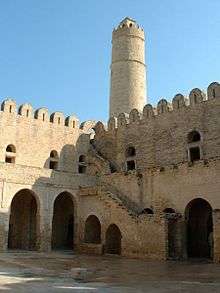Siege of Melite (870)
| ||||||||||||||||||||||||||
The Siege of Melite was the capture of the Byzantine city of Melite (modern Mdina, Malta) by an invading Aghlabid army in 870 AD. The siege was initially led by Halaf al-Hādim, a renowned engineer, but he was killed and was replaced by Sawāda Ibn Muḥammad. The city withstood the siege for some weeks or months, but it ultimately fell to the invaders, and its inhabitants were massacred and the city was sacked.
Background
The Maltese islands had been part of the Byzantine Empire since 535 AD, and archaeological evidence suggests that they probably had an important strategic role within the empire.[1] When the early Muslim conquests began in the 7th century, the Byzantines were threatened in the Mediterranean, so probably efforts were made to improve the defences of Malta. At this point, they might have built a retrenchment which reduced Melite to one third of its original size.[2][Note 1]
A Muslim reconnaissance raid to Malta might have taken place in 221 AH (835–36 AD).[3]
Al-Himyarī's account
Most details about the siege of Melite are known from Kitab al-Rawd al-Mitar, which was written by Muhammad bin 'Abd al-Mun'im al-Himyarī in the 15th century. This account states that the attack on Melite was initially led by an engineer Halaf al-Hādim, who was killed during the siege. The invaders wrote to the Aghlabid ruler Abu ‘Abd Allāh, who ordered Muḥammad Ibn Hafāğa, the governor of Sicily, to send a new leader. The wali Sawāda Ibn Muḥammad was sent, and he continued the siege and captured Melite. Its ruler Amros (possibly Ambrosios) was taken prisoner, and the invaders "demolished its fortress, and they looted, and desecrated whatever they could not carry." Marble from Melite's churches was used to build the castle of Sousse (in modern Tunisia) and the bridge leading to it.[4]
Al-Himyarī further states that the island of Malta remained an uninhabited ruin after the siege, at times being visited by shipbuilders, fishermen and those who collect honey. The island was repopulated by Muslims in 440 AH (1048–49 AD), who built a settlement known as Medina on the ruins of Melite. The Byzantines besieged the new settlement in 445 AH (1053–54 AD) but were repelled.[4]
Analysis
Al-Himyarī's account was discovered in 1931, and the first full edition was published in 1975 in Beirut. The passage relating to Malta remained unknown until being translated to English in 1990. It is the most detailed source about the siege, and it contains some information which is not found in any other sources.[4]
The account suggests that the siege lasted for a few weeks or possibly some months. The rulers mentioned in the source confirm that the siege took place sometime between 255 and 257 AH (between 868 and 871 AD).[4]
Some other sources state that in 870 Malta was already a Muslim settlement, and at the time it was besieged by a Byzantine fleet. After an Aghlabid relief force was sent from Sicily, the fleet retreated without a fight on 28 Ramadan 256 (29 August 870). This resulted in ill-treatment of the island's Greek population, and the bishop was arrested and imprisoned in Palermo, while the island's churches were destroyed.[3]
The use of marble from the churches of Melite in the castle of Sousse is confirmed by an inscription on the castle which translates to:[4]
| “ | Every cut slab, every marble column in this fort was brought over from the church of Malta by Ḥabaši ibn ‘Umar in the hope of meriting the approval and kindness of Allāh the Powerful and Glorious. | ” |
Although al-Himyarī states that Malta remained an "uninhabited ruin" after the siege and it was only repopulated in 1048–49, archaeological evidence suggests that Mdina was already a thriving Muslim settlement by the beginning of the 11th century, so 1048–49 might be the date when the city was officially founded, possibly the date of construction of the city walls.[5]
Notes
- ↑ According to tradition, the city was reduced to its present size during Arab rule, after the siege.
References
- ↑ Cassar, Carmel (2000). A Concise History of Malta. Msida: Mireva Publications. p. 58. ISBN 1870579526.
- ↑ Spiteri, Stephen C. (2004–2007). "The 'Castellu di la Chitati' the medieval castle of the walled town of Mdina" (PDF). Arx – Online Journal of Military Architecture and Fortification (1–4): 4. Archived from the original (PDF) on 15 November 2015.
- 1 2 Bosworth, C. E.; Van Donzel, E.; Lewis, B.; Pellat, Ch., eds. (1987). The Encyclopedia of Islam. Leiden: E. J. Brill. p. 295. ISBN 9004086595.
- 1 2 3 4 5 Brincat, Joseph M. (1995). "Malta 870–1054 Al-Himyari's Account and its Linguistic Implications". Valletta: Said International: 1–52. Archived from the original (PDF) on 6 June 2015.
- ↑ Blouet, Brian W. (2007). The Story of Malta. Allied Publications. p. 41. ISBN 9789990930818.

